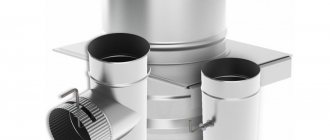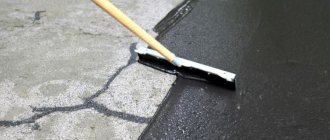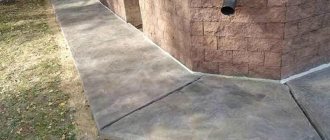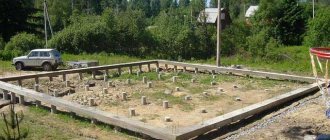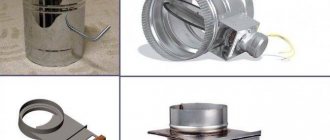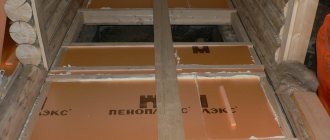Date of publication: April 16, 2020
Stove and fireplace equipment is a source of not only comfort, coziness and warmth, but also a fire hazard. The risk of fire is associated with the use of flammable fuels, as well as high temperatures of internal and external surfaces. It is important to understand that proper installation of heating equipment and components eliminates the risk of fire. It is always possible to make a heating device and chimney absolutely safe for use if you follow the established rules, fire safety standards, and follow all recommendations for installation and insulation of equipment.
This article will discuss the use of mineralite, an insulating material that is used to protect surfaces from the effects of heated areas of fireplaces and chimneys.
Why is it necessary to insulate surfaces near the fire?
The surface of many home and sauna stoves can become very hot during use and heating. Temperatures can rise to 400 degrees Celsius, sometimes even higher. An additional load on the surfaces surrounding the heating device is infrared radiation, which also affects heating. The vast majority of bathhouses and residential buildings are built of wood, or the walls are covered with wooden boards for interior purposes. Exposure to high temperatures and infrared radiation from heating stoves, especially sauna stoves, can lead to fire in wooden areas near the fireplace. Therefore, any fire safety rules dictate the need for protection - insulation of such areas with non-combustible materials. Non-flammable, such insulating surfaces will protect wooden areas from heating, charring, and the risk of fire.
Which method is better to choose?
The finishing of the wall from the stove for different types and sizes of baths is used in different shapes and materials. The main thing is to ensure the fire safety of your steam room and protect the walls from deformation at high heating temperatures.
Otherwise, everything depends on the capabilities and desires of the steam room owners. You can use heat-resistant tiles or expensive tiles, or you can simply cover the walls and ceiling with mineral wool and a layer of metal foil. By leveling the walls with sheets of plasterboard with surfaces not exposed to open fire, you can paint the steam room with heat-resistant paint using Minerita.
If the bathhouse is large, you may not need to perform this work if the conditions of SNIP and fire safety are met. By making the concrete base larger in size than the stove and maintaining a gap of 1 m to the walls, you can safely use the heater and enjoy the steam
In any case, it is important to take care of safety and then your sauna will serve you for a long time
Effective methods of protection
Among the most effective methods of protection against exposure to high temperatures and heat are screens made of:
- mineral wool
- basalt wool
- foam glass
- glass wool
- vermiculite
- drywall
- minerite
- of stainless steel
Using the materials listed above, as a rule, so-called screens are created - surfaces of a certain width, length and thickness, installed in close proximity to the heating product and sections of the chimney.
Floor
The insulation process should begin from the floor. There are two floor design options:
- leaking;
- leak-proof.
Solid
Thermal insulation of non-leaking (solid) floors is carried out by analogy with floor insulation along joists. A subfloor is laid along the floor beams, and mineral wool slabs are laid. A layer of waterproofing must be laid on top.
Leaking
Leaky floors require a slightly different approach. They must allow water to pass through, which spills onto the floor in the washing compartment or in the steam room combined with the washing room. At the same time, they should not let the cold from the ground into the room.
The most common option is a heated floor on the ground with an insulating layer of polystyrene foam or EPS. In cross-section, the structure consists of the following layers:
- foundation soil;
- compacted sand layer;
- gravel drainage bedding;
- rough screed;
- insulation;
- waterproofing;
- reinforcing mesh;
- finishing screed.
Removable antiseptic wooden ladders are laid on top of the finishing screed, acting as a finishing floor. After all procedures are completed, the ladders in the bathhouse are raised and dried.
What is minerite?
It is an insulating material in the form of a cement-fiber panel (slab). It is often used for finishing work on building facades. It is heat and fire resistant, therefore it is often used in bathhouses, steam rooms and residential areas for wall insulation. The composition includes cellulose (about 10%), cement (about 60%) and mineral filler components (about 30%). The composition may vary depending on the manufacturer. Plates of material come in various sizes and colors. On top of mineralite slabs it is possible to carry out decorative finishing with other materials. It is characterized by high quality, therefore it is actively used during construction work.
Minerite is used:
- during the construction of facilities with increased fire safety requirements
- for decorative cladding of buildings
- for creating loggias and covering balconies
- for installation of ventilation facades
- as a thermal insulation material for fireplaces and stoves
Compound
Minerite is known to many as a fiber cement panel, which has been used until today as a finishing for ventilated building facades. The plate differs from many similar materials in its increased impact resistance. This panel is practically not deformed and can withstand heavy physical loads. Minerite slabs for baths are produced using energy-saving and environmentally friendly technologies.
The protective panels contain the following ingredients:
- cement;
- cellulose;
- limestone;
- sand;
- mica.
Main characteristics
Minerite slabs have a wide range of applications. This is largely due to a certain set of qualities – universal and convenient. So, among the characteristics of this material are:
- A light weight
- High strength
- Environmental friendliness
- Sound absorption
- No emissions of harmful substances when heated
- Increased resistance to various loads, including temperature changes
- Moisture resistance, waterproofing properties
Light weight, environmental friendliness, non-flammability, moisture resistance and resistance to temperature changes and influences have made this material in demand for creating protective screens in bathhouses, saunas, and country houses when using solid fuel heating devices.
For regiments
Shelves are an indispensable attribute of a steam room. True, they are Finnish and Russian, but for some reason they don’t talk about this very often.
The difference between the Finnish and Russian regiments is only in the design, but the material for the regiments in both bathhouses is the same.
ADVICE! Use cheaper lumber from softwood to create the frame of the shelves, and make the shelves themselves from hardwood, for example, linden, aspen, ash, abasha, etc.
Planken is often used as a material to create shelf seats in a bathhouse - it is loved for its smoothed ribs. Although this is, in principle, a façade material.
Linden shelf, Extra grade
Read more about the shelves here.
Rules for installing mineralite panels to the wall
There are various ways of attaching slabs to wooden walls next to the furnace equipment:
- If the stove is very far from the wall, the insulation can be attached directly to the wall
- If the stove is about 50 cm away from the wall, the mineralite should be mounted on the wall with a gap of about 3 cm. Ceramic bushings should be installed in the gap itself, which should be located between the wall and the insulation board
- If the stove is located quite close to the wall of the building, it is recommended to install several insulation panels at once. One sheet can be installed flush against the wall, the second sheet can be installed with a gap, the distance of which is determined by the length of the bushings
Important! When placing a mineralite panel on the wall of a wooden structure, especially a bathhouse, it is recommended to leave about 30 mm of clearance between the bottom of the panel and the floor. This action will ensure free circulation of oxygen, which will prevent strong heating of the wall surface.
For greater reliability, it is recommended to install special supports between the bottom of the slab and the floor, which can be removed after shrinkage occurs. After removing the supports, tighten the mounting screws completely. The floor directly under the sauna heater-stove should also be reliably insulated. To do this, you need to place a sheet of mineralite under the hearth, which can be fixed with self-tapping screws. Deflection and deformation of the insulation under the stove can only be avoided if the floor at the installation site is level.
Important! It is necessary to maintain safe distances between the mineralite sheets and the stove equipment, including the chimney: it must be at least ten centimeters.
Fire retardant materials
To generate a large amount of heat you need either electricity, gas, or wood. Thus, we cannot avoid the use of fire hazardous items in the bathhouse, such as stoves. But it is in our power to surround them with fire-resistant materials - this is an urgent need for a bathhouse, because bathhouses burn down more often than they are destroyed for any other reason.
There are three “nodes” where such materials are used. At the same time, both the tasks and the materials themselves will be different.
Non-combustible insulation for chimneys
A chimney can be considered no less (or even more) dangerous than a stove. Gases flow through it at a temperature that is higher than the ignition temperature of wood. And the sparks that fly out of it can set the roof on fire.
Read also: Incandescent lamp (Ilyich lamp)
Therefore, it is advisable to install a spark arrester on the top of the chimney, inspect the chimney itself regularly, do not burn coniferous trees, because they cause many problems, and most importantly, keep all flammable materials from the chimney at a safe distance.
When passing through the ceiling, the last problem is solved with the help of metal boxes lined with mineralite slabs, and inside filled with non-combustible materials - for example, expanded clay, ceramic fiber. If the GOST dimensions are observed, such a box will protect the wooden floor, preventing it from heating up to the ignition temperature.
We wrote about the box here.
Fireproof for the stove
Steam rooms are rarely large, which means it is not always possible to move the stove away from the wall to a safe distance so that it does not burn the wall. Therefore, for a bathhouse you need a fireproof material for the stove that will protect the wall.
For example, mineralite slabs successfully cope with the task, but on the condition that you install them not flush against the wall, but with an air gap of a couple of centimeters, which is provided by ceramic bushings placed on the fasteners. This technology is applicable to wooden walls.
You can also experiment with brick. When the firebox goes through and goes into another room, a cutting wall is made of brick. The section of the firebox passing through the wall can be insulated using modern materials - the same ceramic fiber that can withstand more than 1200 degrees!
ATTENTION! Regular mineral wool will not last long; you will need to check its condition from time to time. You can also cover the stove itself with brick, creating a casing for it.
It must have vents with doors. But keep in mind that a brick casing is good for those who love a Russian bath and who have a closed heater in their stove. The casing will increase the heating time of the steam room
You can also cover the stove itself with brick, creating a casing for it. It must have vents with doors. But keep in mind that a brick casing is good for those who love a Russian bath and who have a closed heater in their stove. The casing will increase the heating time of the steam room.
At the bottom of the stove, either an individual foundation is made, or just a brick pedestal, and a stainless steel sheet is also placed in front of the firebox.
There should be a pre-furnace sheet in front of the firebox
Installation of slabs on a wooden wall can be roughly divided into the following stages:
- Installation of brackets on a wall requiring insulation (no longer than the thickness of the insulation board itself)
- Laying preliminary insulation (for example, basalt wool) with dowel fastening - umbrellas
- Installation of a frame - metal profiles placed vertically and horizontally to obtain a conditional rectangle, square, or other chosen shape
- The insulating material itself is mounted directly onto the resulting frame. For slab thicknesses up to 15 mm, you can use simple self-tapping screws for fastening. When the slab thickness is more than 15 mm, clamps are used.
- The joints should be carefully treated with heat-resistant sealant
- If there is a corner, it is recommended to cover it with a metal profile
Tip: it is recommended to use a special sealing tape between the frame and the mineralite in cases where self-tapping screws are used for installation.
Applying paint
Painting fireplaces requires preparation, just like any other construction work. First you need to make sure that you have purchased exactly the composition you need.
You also need to prepare the following tools:
- soft cloth;
- sandpaper;
- water;
- brush;
- roller;
- copper sulfate solution;
- sulfuric acid solution;
- spray.
First, prepare the surface that will be painted. It is cleaned of dust and dirt. Metal parts are cleaned with fine sandpaper. Be sure to remove greasy stains with a soft cloth soaked in a solution of water and salt. Soot can be easily removed with a solution of hydrochloric acid, and rust with a 10% mixture of copper sulfate.
It is recommended to apply the paint to a slightly warm surface using a brush, roller or spray - whichever is more convenient. In total, you need to make 2-3 layers, each of them should be allowed to dry thoroughly before applying the next one. The fireplace must be allowed to dry for several days; it cannot be used until the paint has completely hardened.
Professional installation of bath equipment and insulation
Any furnace equipment is a source of fire hazard, so the installation of fires and installation of insulating materials must be carried out by professionals. Insulating materials vary, and not all are suitable for contact with very hot surfaces. Even mineralite, although it is a fire-resistant material, with increased exposure to high temperatures and fire can begin to melt or char, creating a risk of fire. Minerite is suitable for insulation purposes, but it should be installed with knowledge of safe distances, maximum operating temperatures, equipment heating temperatures, and other nuances. This material is often installed together with other insulation solutions to achieve the highest level of safety.
Our specialists have impressive work experience and unique knowledge, which is recommended for anyone who is organizing their bathhouse, home, or installing a heating product. The company’s specialists will prepare an individual plan for installing insulation and carry out a range of installation works with the selected insulation material within a prompt time frame.
Attention! Only professional installation of mineralite and other insulating solutions can be a good guarantee of fire safety, health and property.
Prevention of poisoning
Today, the answer to the question of whether asbestos is harmful to health is already obvious and beyond any doubt.
Therefore, it is extremely important to remember that the use of amphibole mineral is strictly prohibited under any circumstances. When using the more common chrysotile, the following instructions must be observed:
- when coming into contact with asbestos materials, use protective equipment;
- waste and dust should be stored in a sealed container, then disposed of using a special technology;
- use only dense products: they should not crumble;
- the mineral cannot be sprayed in the air;
- periodically monitor the permissible level of asbestos fibers in the production area;
- undergo regular medical examination.
When working with building materials that contain asbestos, it is extremely important to protect the respiratory system Source laboratoria.by
The chemical composition of sheet asbestos is identical to the material discovered in the Urals. Having decided to remove the asbestos roof, you should prepare a change of clothes. Upon completion of all work, it is better to dispose of it. Some builders recommend lightly moistening the slate with plain water on the eve of dismantling. In this case, asbestos dust will not be able to rise into the air.
Today, asbestos-cement slabs are practically not used in construction. If possible, they should definitely be replaced with a building material of similar characteristics, but safer. Panels containing asbestos continually release harmful microfibers into the environment. And people nearby will inhale them every day.
Asbestos-cement panels release harmful microfibers into the environment, which, when inhaled, are harmful to human health. Source samstroy.com
Cutting and processing of fiber cement panels
Fiber cement boards are a facing material popular due to their excellent durability (minimum service life is 50 years) and aesthetics. Cutting and processing of fiber cement panels is carried out using specialized equipment in strict compliance with safety measures. This is a labor-intensive process that requires skill and care. stored and cut carefully. It lends itself well to processing, but due to its fragility it can be damaged if handled ineptly. It is better to entrust this task to professionals.
Minerite slab
Previous reviews of the construction magazine have already described what minerite is. This is a fiber cement board with high fireproof and waterproofing properties. In addition, its difference from other similar building materials is the absence of any harmful substances in its composition.
Even earlier, when there was no mineralite, it was partially replaced by asbestos. And although asbestos does not burn, it is harmful to human health, therefore, over the past decade, the production and use of this material in construction has been significantly limited.
As for mineralite slabs, they are made only from natural materials, such as:
- Cellulose;
- Limestone;
- Mica;
- Sand;
- Cement.
But in addition to being environmentally friendly and harmless for everyday use, mineralite slabs have other, no less important, advantages.
These include primarily the following:
- High fire-resistant properties, as well as very decent strength characteristics;
- Almost complete absence of deformation during operation (even with significant temperature changes);
- Ease of installation and versatility in use.
Minerite slabs do not have any significant drawbacks, except that they do not have a very presentable appearance. However, today there is decorative mineralite, so if there is no need for additional surface finishing, then perhaps this is what you should give your preference to.
Characteristics of mineralite slab
As you can see, the mineralite slab has a number of serious advantages compared to other similar building materials. It can be used to protect baths and houses from fire, completely replacing materials such as fiberglass, natural stone and metal.
Minerite slabs have the following technical characteristics:
- The mass of the 1st mineralite slab is only about 26 kg;
- The length of the material ranges from 1200-3600 millimeters, and its width can be 450-1500 millimeters;
- Completely environmentally friendly and harmless composition.
All of the above characteristics of mineralite slab make it a very convenient and versatile building material to use.
Application
The scope of application is extensive and covers the sphere of private and capital construction. Let's look at the main areas:
- Instead of asbestos. Asbestos releases substances harmful to people that can make people feel worse. Therefore, when exposed to high temperatures, mineralite is used. And these are baths, saunas, Russian stoves, industrial premises where a high fire safety limit is required. By the way, the “LV” series, which was not previously mentioned, is suitable for saunas. It is lightweight, has many color options, does not burn and can withstand temperatures up to 180 degrees Celsius. The material showed itself to be absolutely normal in matters of zoning application.
- Where it is damp and humid. These can be basements and semi-basements, washing rooms in bathhouses, bathrooms, rooms near swimming pools. Minerite for baths not only does not deteriorate from moisture and protects the surface of load-bearing walls from destruction, but also prevents the formation of fungus and mold. At the same time, if you have a wooden house, then the surface of the walls can be covered with mineralite, and tiles and porcelain stoneware can be laid on it without additional insulation from water. You can do the same in the kitchen, and then hang wallpaper.
Protection of a chimney in a bathhouse with mineralite
The scope of application of such finishing options is so diverse that it covers the private sphere and permanent buildings. For example, mineralite is used to decorate the exterior facades of houses, to create safety zones inside baths and saunas, even in houses where there are full-fledged fireplaces. In particular, mineralite can be used for finishing utility rooms, loggias, balconies and other places. The variety with the “RK marking” is suitable for finishing facades.
Choosing the type of painting
Painting with chalk or lime – the base of a brick (stove or fireplace) can be painted with your own hands using limestone whitewash. When mixing the composition (100 grams of lime, 40 grams of salt diluted in water), it should resemble liquid sour cream. Before painting, the surface of the fireplace must be prepared, cleaned of dirt and dust using a scraper or spatula. Uneven areas must be filled with putty (brick flour and latex paint).
You can also paint the stove or fireplace in your home with chalk. it should be sifted and diluted with low-fat (preferably skim) milk, to remove yellowness, you can add blue. Before painting, the base is moistened with water. The painting process is long, you need to paint in 2-3 layers. Layers are applied only when the previous one is completely dry.
If the question “How to paint the stove? “If you are inclined towards more modern methods, then when choosing paint the main emphasis should be on its heat resistance.
Painting with oil or enamel paints will increase heat transfer; it is better to choose a dark color, such a surface gives off more heat. You should not choose glossy or smooth surfaces; they can significantly reduce efficiency.
Water-based paint is a common option, applicable to brick and concrete surfaces, plaster or drywall. Dries quickly, safe, easy to apply with a brush or roller, easy to choose the right shade. The disadvantages of this are the speed of absorption and its price is higher than other means for upgrading the furnace.
If the oven is manufactured to the required standards, then surface heating can reach 80 degrees. For such temperatures, synthetic-based paints are suitable - nitro paints, pentaphthalic paints. If the paint base contains drying oil, it may darken at temperature.
Heat-resistant paints. sold in stores have good heat dissipation, but their palette is not large. If the colors presented do not suit you, then you can paint the brick stove with latex paint after preliminary priming.
Silicon-organic enamel is heat-resistant, durable, this paint should be applied in a thin, even layer, for optimal color in 2-3 layers.
How to paint a brick stove
There are no particular difficulties in painting a brick stove, so anyone can do it, even if they have not done it before.
Painting, especially for a newly plastered stove, occurs only after all preparatory work has been followed and completed, otherwise it will not be effective and will have to be repeated after a short period of time.
For coloring you will need the following equipment:
- Container for coloring agent;
- The coloring solution itself;
- Convenient brush and roller.
Prepare a coloring solution and apply it in the required number of layers. It is recommended to apply the paint in two or three thin layers, using both a brush and a roller if possible. A brush can add texture to the outside of the fireplace, and a roller can distribute the paint evenly over the entire surface. If desired, patterns can be applied to the final layer of paint.
Stove painted with lime mortar
Painting the stove with a special varnish
Stove painted with natural varnish and drying oil
Stove painted with enamel
Price
Minerite (another name is fiber cement board) is sold in all construction markets. Compared to other analogues, it is inexpensive. For example, the product is a thermoregulating product for protecting wooden surfaces from fire, size 0.6 * 1.2 meters, thickness 0.8 cm will cost the buyer 1,170 rubles.
It turns out that for the walls in the bathhouse you need about 4 slabs per wall and 2 for the ceiling, which will cost 7,000 rubles. Don’t forget about the basalt material, which is attached as a substrate to the wall, and its price is 550 rubles per square meter. For 1,170 rubles you can buy a standard slab, but material with imitation stone, wood or brick will cost more.
With all the parameters described above, a slab with imitation will cost 2,600 rubles. This is a non-flammable A1 stove, with a scope of use in saunas and baths, both for electric stoves and for wood-burning fireplaces.
Areas of application
The versatility of mineralite justifies its demand for various types of work.
- Fiber cement boards are suitable for installing screens around hot stoves, hot fireplaces and heat-emitting equipment in saunas.
- Fire-resistant partitions are built from mineralite slabs, dividing the area into fire zones, equipping a safe exit during evacuation. Using a certain technology, walls, ceilings, chimney systems, and ventilation ducts are sewn up in fire hazardous areas.
- High moisture resistance allows the use of this material where there is excessive dampness and humidity (showers, swimming pools). In this case, additional waterproofing treatment (aqua blocks) is not required.
- Can be used as a base for facing tiles and other waterproof materials for final finishing.
- Thermal insulation and excellent adaptation of the material to temperature changes suggest its use for cladding interior spaces and exterior walls of buildings, including loggias and balconies.
- Serve as a smooth, waterproof base under wood stoves, wall and floor tiles.
With moderate weight, the slabs are characterized by increased strength, impact resistance and durability. It is also important that the components of mineralite contribute to the self-cleaning of the surface of the slab. And in addition to excellent structural properties, the material is endowed with aesthetic capabilities. The slabs are produced in different color variations. A variety of decorative colors on the front part of the coating allows you to cover facades with mineralite during the reconstruction and construction of residential and administrative buildings.
How to cut Kedral?
Siding Kedral
The click can easily be processed in various ways - it can be
cut
, milled and drilled. To cut the boards, you can use an electric circular saw with a carbide blade and diamond-coated or hardened tips.
Interesting materials:
How to fertilize your lawn in early spring? How to fertilize the lawn in the heat? How to fertilize apple and pear trees? How to fertilize apple trees in summer? How to fertilize apple trees in August? How to fertilize apple trees in July? How to fertilize potatoes for a good harvest? How to fertilize potatoes after flowering? How to fertilize hosta in summer? How to fertilize the Multiflora chrysanthemum?
Reviews
Minerite 630x1200 mm and other products in this category are available in the catalog of the Leroy Merlin online store in Moscow at low prices. Read the detailed characteristics and description, as well as reviews of this product, to make the right choice and order the product online.
Buy products such as Minerite 630x1200 mm in the Leroy Merlin online store, having first checked their availability. You can receive the goods in Moscow in a way convenient for you; to do this, read the information about delivery and pickup.
You can always place an order and pay for it online on the official website of Leroy Merlin in Russia. For residents of the Moscow region, we not only have low prices for goods such as “Minerite 630x1200 mm”, but also fast delivery to cities such as Moscow, Balashikha, Podolsk, Khimki, Korolev, Mytishchi, Lyubertsy, Krasnogorsk, Elektrostal, Kolomna, Odintsovo, Domodedovo, Serpukhov, Shchelkovo, Orekhovo-Zuevo, Ramenskoye, Dolgoprudny, Pushkino, Reutov, Sergiev Posad, Voskresensk, Lobnya, Ivanteevka, Dubna, Yegoryevsk, Chekhov, Dmitrov, Vidnoye, Stupino, Pavlovsky Posad, Naro-Fominsk, Fryazino, Lytkarino, Dzerzhinsky, Solnechnogorsk, Istra and Zhukovsky.
